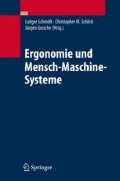Auszug
Komplexität ist ein allen Entwicklern und Benutzern technischer Systeme wohl vertrautes Phänomen. Es gibt kaum ein vergleichbares Konstrukt, das intuitiv so klar zu sein scheint, sich jedoch einer rigorosen wissenschaftlichen Analyse so hartnäckig entzieht. Selbst erzeugte Komplexität ist in Mensch-Maschine-Systemen besonders kritisch zu bewerten, da sie Leistung wesentlich vermindern kann und oft zu unnötig hoher mentaler Beanspruchung führt. Im Beitrag wird mit der Grassberger-Komplexität ein Ansatz aus der theoretischen Physik vorgestellt und auf die Ergonomie übertragen, der sich durch seine konzeptuelle Klarheit und hohe Konstruktvalidität auszeichnet. Anhand eines didaktisch aufbereiteten Fallbeispiels für die Informationseingabe mit mobilen Computersystemen wird eine exemplarische Komplexitätsberechnung durchgeführt und diskutiert.
Access this chapter
Tax calculation will be finalised at checkout
Purchases are for personal use only
Preview
Unable to display preview. Download preview PDF.
Literatur
Bialek W, Nemenman I, Tishby N (2001) Predictability, complexity and learning. Neural Computation, 13(3), 2409–2463
Cover TM, Thomas JA (1991) Elements of Information Theory. Wiley, New York (NY)
Crutchfield JP, Feldman DP (2003) Regularities Unseen, Randomness Observed: Levels of Entropy Convergence. CHAOS, 13(1), 25–54
Der Duden — Das Fremdwörterbuch (2000) Dudenverlag, Mannheim
Ebeling W, Pöschel T, Albrecht K-F (1995) Entropy, Transinformation and Word Distribution of Information-Carrying Sequences. International Journal of Bifurcation and Chaos, 5(1), 51–61
Ebeling W, Freund J, Schweitzer F (1998) Komplexe Strukturen: Entropie und Information. Teubner, Stuttgart
Gallagher R, Appenzeller T (1999) Beyond Reductionism. Science, 284 (issue 5411), 79
Grassberger P (1986) Toward a Quantitative Theory of Self-Generated Complexity. International Journal of Theoretical Physics, 25(9), 907–938
Kieras D, Polsen PG (1999) An approach to the formal analysis of user complexity. International Journal of Human-Computer Studies, 51(1), 405–434
Küpfmüller K (1954) Die Entropie der deutschen Sprache. Fernmeldetechnische Zeitschrift 7, pp. 265–272. Zitiert nach Meyer-Eppler W (1969) Grundlagen und Anwendungen der Informationstheorie. Zweite Auflage. Springer, Berlin
Schlick C, Winkelholz C, Motz F, MacKinnon S, Patterson A (2004) A Complexity Study of Human-Machine Interaction on Motion Platforms. IEEE International Conference on Systems, Man, and Cybernetics 2004
Schlick C, Winkelholz C, Motz F (2005) A Novel Method for Measuring the Complexity of Human-Computer Interaction. In Proceedings of the 11th International Conference on Human-Computer Interaction, Las Vegas, Nevada, USA.
Schlick C, Winkelholz C, Motz F, Luczak H (2006) Self-Generated Complexity and Human-Machine Interaction. IEEE Transactions on Systems, Man, and Cybernetics — Part A: Systems and Humans, 36(1), 220–232
Shalizi CR (2006) Methods and Techniques of Complex Systems Science: An Overview. In: TS Deisboeck, J Yasha Kresh (Eds.), Complex Systems Science in Biomedicine. Springer, New York (NY), pp. 33–114
Shannon CE (1948) A Mathematical Theory of Communication. Bell System Technical Journal 27(3), 379–423
Shannon CE (1951) Prediction and entropy of printed English. Bell System Technical Journal 30(1), 50–64
Wegener I (2003) Komplexitätstheorie. Springer, Berlin
Author information
Authors and Affiliations
Editor information
Editors and Affiliations
Rights and permissions
Copyright information
© 2008 Springer-Verlag Berlin Heidelberg
About this paper
Cite this paper
Schlick, C.M., Winkelholz, C. (2008). Komplexität und Mensch-Maschine-Interaktion. In: Schmidt, L., Grosche, J., Schlick, C.M. (eds) Ergonomie und Mensch-Maschine-Systeme. Springer, Berlin, Heidelberg. https://doi.org/10.1007/978-3-540-78331-2_20
Download citation
DOI: https://doi.org/10.1007/978-3-540-78331-2_20
Publisher Name: Springer, Berlin, Heidelberg
Print ISBN: 978-3-540-78330-5
Online ISBN: 978-3-540-78331-2
eBook Packages: Computer Science and Engineering (German Language)

